Our translation of the article "Diagonāles latvju rakstos." which appeared in the July 1, 1932 issue of Audzinātājs (Educator).1 The article deals with how to translate oblique elements of Latvian signs to an up-down-across matrix of squares as visualized on a chess or checkerboard and imposed by the weaving loom. We have corrected and added explanatory diagrams.
The diagonal is a concept intrinsic to the understanding of Latvian signs, for the majority of Latvian signs in ethnographic items are created on the diagonal, and this manner of rendering is inseparable from the signs themselves. The diagonal, for our purposes here, should be thought of in the same way as do chess and checkers players, when they talk about white diagonals, black diagonals, and major diagonal. We call it a diagonal when boxes line up on quadrille-ruled paper (or any similar construct as a chess table or similar) in a diagonal direction, that is, the boxes touch at the corner, not at the sides.
On a chess board, the sequences of diagonals, are marked by alternating black and white colors. Such an alternating pattern, however, is rarely encountered in Latvian signs. Far more often, a single, double, or triple-wide [subsequently referred to single, 2-abreast, 3-abreast,.. for clarity to indicate the number of horizontally adjoining stitches/boxes in a single row] diagonal is filled in on an otherwise empty field, or groupings alternate or are combined in other ways.The following diagrams will help to explain the use of diagonals.
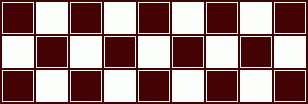 Figure 1.
Figure 1.Looking at the top row [Figure 1.], there are five black and four white diagonals.
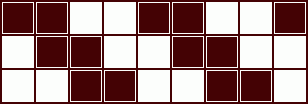 Figure 2.
Figure 2.Looking at the top row [Figure 2.], there are once again five black and four white diagonals. But this time, there are two black together, then two white, etc. The diagonals no longer crisscross in both directions (covering the field as far as they can go, proceeding from the top row either to the right or left), but in one direction only.
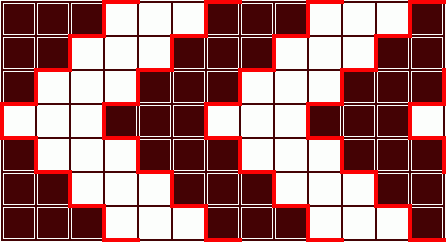 Figure 3.
Figure 3.In this diagram [Figure 3.], proceeding again from the top row, there are groups of three black, three white, then three black and three white again, etc. The diagonals descend toward the left from the top row, later flip to descend toward the right.
A zigzag boundary line [which we have shown in red in Figure 3.] runs between the white and black diagonals. By drawing such zigzag boundary lines in both directions (i.e., obliquely to the left and obliquely to the right) forming two-abreast, three-abreast, etc. diagonals and without coloring the diagonal boxes themselves, we get an alternating two-abreast, three-abreast. etc. diagonal mesh. (If you want to see what this mesh looks like, draw it by hand on quadrille-ruled paper. Drawing it carefully will readily prevent any confusion.)
Without familiarity with this mesh component [i.e., the zigzag line], it is not possible to understand the relationship between the parts of Latvian signs which are created by diagonals, e.g., in the following diagram of a roof gable [as represented by the Jumis sign]. Such a mesh of diagonals also helps in understanding the zigzag lines separating the ornament from the field and parts of the ornament from each other, e.g. how the branches of the fire-cross [swastika] relate to the spaces separating them.
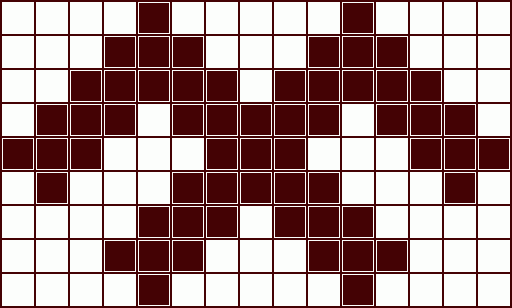 Figure 4.
Figure 4.Latvian sign motif [Jumis, Figure 4.], three-abreast diagonal.
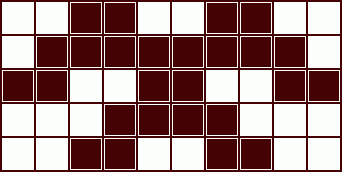 Figure 5.
Figure 5.The same Jumis figure as prior, two-abreast diagonal [Figure 5.].
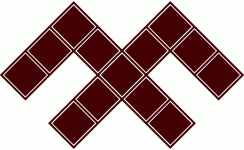 Figure 6.
Figure 6.The same Jumis figure yet again, this time formed by oblique squares conjoined along their sides.
In the last diagram [Figure 6.], one can best observe the desired proportions: the branches are as wide as the spacing between them, while the length of the branches is double their width.
The Jumis diagram in Figure 6., constructed of oblique squares, represents the design ideal. For the weaver, the challenge now is to translate the oblique "ideal" to the limitations of the non-oblique rectilinear "chess board". The author now works backwards, that is, from Figure 6. to Figure 5., and from Figure 6. to Figure 4. We have added explanatory diagrams.
For a Jumis created using two-abreast diagonals, in the place of each oblique square [as seen in Figure 6.], one substitutes a quadrilateral of two horizontally adjacent squares, that is, twice as wide as high:
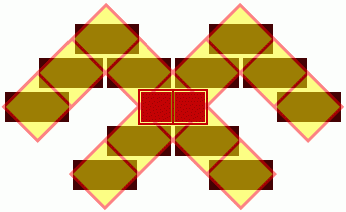 Each oblique square in Figure 6. is translated into two-abreast non-oblique squares to form the diagonals as seen in Figure 5. [Our diagram]
Each oblique square in Figure 6. is translated into two-abreast non-oblique squares to form the diagonals as seen in Figure 5. [Our diagram]For a Jumis created using three-abreast diagonals, in the place of each oblique square, one alternates a cross:
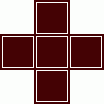 Figure 7.
Figure 7.and a larger [doubled on both sides, so quadrupled] square:
 Figure 8.
Figure 8.in a three-abreast diagonal mesh, using only the cross and quadrupled square:
 Each oblique square in Figure 6. is translated into alternating crosses and quadrupled (2x2) squares to form the diagonals as seen in the three-abreast diagonals of Figure 4. [Our diagram]
Each oblique square in Figure 6. is translated into alternating crosses and quadrupled (2x2) squares to form the diagonals as seen in the three-abreast diagonals of Figure 4. [Our diagram]In a three-abreast diagonal mesh, only a cross or quadrupled-square should take the place of one oblique square. All angular oblique Latvian signs, e.g., fire-cross, suns, etc. can be created on a two-abreast, three-abreast, also 5-, 7-, etc. [odd numbers] abreast diagonal mesh, maintaining the intrinsic proportions of the signs elements and spacing in-between.
Signs should not be created on a 4-, 6-, etc. [even numbers over 2] abreast diagonal mesh because crossing zigzag diagonals can only change direction after leaving space for two empty adjacent squares [or filling in two adjacent squares — as can be seen in Figure 5.] making the design pattern less pleasing to the eye.
If two even-abreast or two odd-abreast diagonals intersect (chessboard white with white and black with black), then a cross with one box in the center is formed. [See correction in our second diagram, below.]
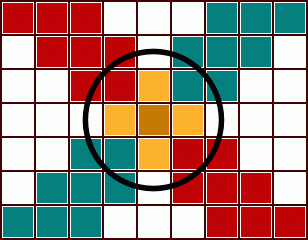 A pair of 3-abreast diagonals cross. A one-box-thick cross (gold) is formed at the intersection, with on box (darkened) at the center of the cross. Even-abreast crossing diagonals actually form two adjoining boxes at the center [Our diagram]
A pair of 3-abreast diagonals cross. A one-box-thick cross (gold) is formed at the intersection, with on box (darkened) at the center of the cross. Even-abreast crossing diagonals actually form two adjoining boxes at the center [Our diagram]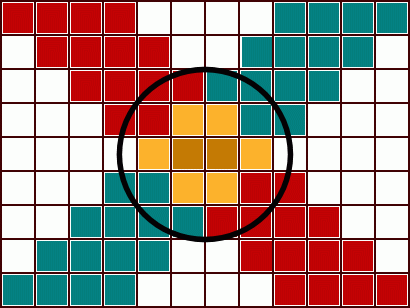 A pair of 4-abreast diagonals cross. A 2:1 aspect cross (gold) is formed at the intersection, not a simple 1:1 cross as in prior diagram. Thus, even-abreast crossing diagonals create an oblong rectangle at the center. Note one empty box separating the diagonals in one direction while two empty boxes separate the diagonals in the other, yielding an uneven appearance. [Our diagram]
A pair of 4-abreast diagonals cross. A 2:1 aspect cross (gold) is formed at the intersection, not a simple 1:1 cross as in prior diagram. Thus, even-abreast crossing diagonals create an oblong rectangle at the center. Note one empty box separating the diagonals in one direction while two empty boxes separate the diagonals in the other, yielding an uneven appearance. [Our diagram]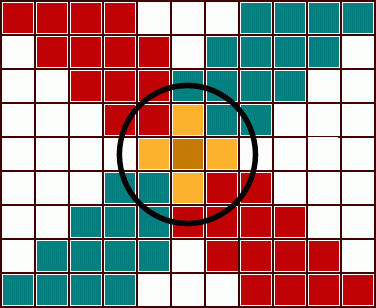 We have no evidence that weavers use this "cheat" where one column is eliminated — the diagonals only appear to be continuous. However, it ensures that a single empty box separates diagonals on each side, thus forming a cross made of single-width adjoining boxes at center. [Our diagram]
We have no evidence that weavers use this "cheat" where one column is eliminated — the diagonals only appear to be continuous. However, it ensures that a single empty box separates diagonals on each side, thus forming a cross made of single-width adjoining boxes at center. [Our diagram]If an even diagonal intersects an odd diagonal (diagonals of different colors on a chessboard) then a four-box square appears in the center.
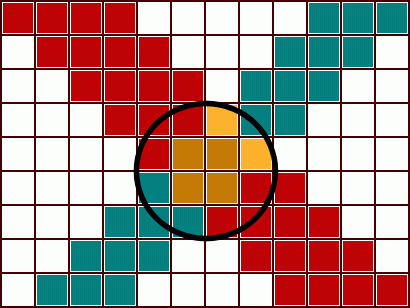 A 4-abreast and 3-abreast diagonal cross. At the intersection (gold), a 2x2 box (darkened) is formed at the center of the cross. One empty box separates the diagonals at top and at right, two at left and at bottom. [Our diagram]
A 4-abreast and 3-abreast diagonal cross. At the intersection (gold), a 2x2 box (darkened) is formed at the center of the cross. One empty box separates the diagonals at top and at right, two at left and at bottom. [Our diagram]In order to completely separate objects with diagonals from each other, an empty diagonal of at least two-abreast is required, otherwise objects could potentially touch at the corners.
If the zigzag line delimiting the diagonal always changes direction along each box and never after two boxes [that is, keeping the diagonal uniform on a 45-degree oblique angle], this enhances the beauty of diagonal patterns.
A facsimile of the original article ![]() is available.
is available.
Regarding the aforementioned fire-cross (swastika), read on for the role of the js/index.html.
| 1 | Retrieved April 2, 2021 at http://periodika.lndb.lv/periodika2-viewer/view/index-dev.html?lang=fr#panel:pa|issue:/p_001_audz1932n07-08|article:DIVL101|query:A%20Danc%C4%ABtis|issueType:P |
 Gallery
Gallery